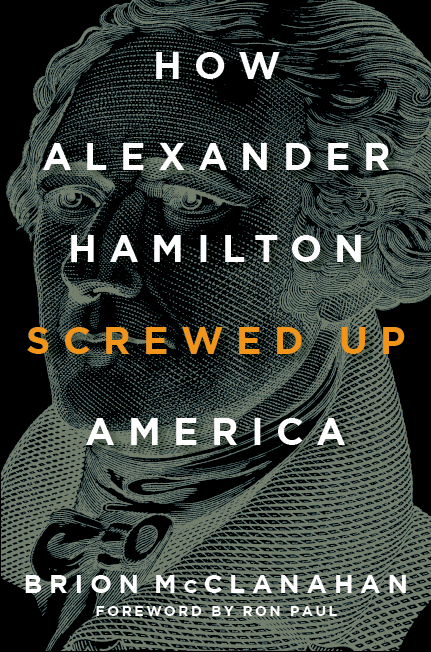A review of How Alexander Hamilton Screwed Up America by Brion McClanahan, Regnery History, 2017.
A thinking American must choose between Hamilton and Jefferson, whose contrary visions of the future were contested in the first days of the Constitution. If you are happy with big government, big banks, big business, big military, and judicial dictatorship, then you have Alexander Hamilton to thank. His legacy of nationalism, centralisation, crony capitalism, and military-industrial complex is all around us.
If you prefer the Jeffersonian version of an American regime (or even if you don’t), Brion McClanahan’s new book is for you—How Alexander Hamilton Screwed Up America. McClanahan, who is proving to be one of the ablest truly relevant historians of our time, has given us a definitive, deeply-researched chapter and verse and long perspective of who this bad man was and how he is, Constitutionally, the fountain of our current discontents.
When Hillary Clinton called we Americans “deplorables” (in contrast to the rich foreign sophisticates who surround her) she was simply channeling Alexander Hamilton who said that “the people are a great beast.”
Hamilton’s final resting place is the old Episcopal church just off Wall Street, one of the few early buildings left in Manhattan. I once visited a friend who was working on Wall Street and was told that the stockbrokers and bankers have a tradition of keeping fresh flowers on Hamilton’s grave. Nothing could be more appropriate.
And it is a measure of Hamilton’s dominance of the American regime that the habitués of Wall Street are now immensely powerful and respectable. Hamilton’s Jeffersonian opponents called them “speculators” and “jobbers.” Not that Jeffersonians were opposed to enterprise or honest pursuit of profit. But for them Hamilton’s friends were engaged in dubious machinations to prey on the wealth produced by others, plausible extortion using the government and co-opting the rest of society into their schemes. There is certainly enough corruption in the history of Wall Street and the connected banking interests to lend credibility to the Jeffersonian view.
This book is a deeply-researched and well thought- out examination of how the immigrant bastard (literally) on the make, Hamilton, lied the Constitution into a centralization and elite wealth-producing instrument that was not the limited federal government ratified by the people of the States. He laid the foundations that subsequent Supreme Court usurpers like John Marshall, Joseph Story, and finally Hugo Black used to turn the original Constitution upside down.
Remember this—Hamilton and Marshall and Story and their accomplices lied. In office they clandestinely repudiated their statements made while encouraging ratification of the Constitution and immediately began to reinterpret it by verbal gymnastics and false history. Their goal, successful over time, was to establish the centralized regime that had been repudiated by the American people in the Philadelphia Convention and the ratifying conventions.
The lying centralisers said they were working for a stronger government for a better country. This may be true, but we miss here the hidden engine of motivation for this political movement—greed. The desire for a government to profit those who could manipulate it. Federalists moaned about the danger of democracy. The wild majority might vote themselves the wealth of their betters. A strong “energetic” executive and supreme judiciary were needed to prevent this.
But as John Taylor replied to John Adams, this is not the way it happens usually. Rather, the people go about their business quietly unless greatly provoked. The danger is from interested minorities of the clever and well-connected who have endless devices to use the government to parasite off the real wealth producers.
For Hamilton, a government debt was “a public blessing,” making for a strong and stable government. Meaning that the wealthy could increase their wealth through the tax-free interest on government bonds paid by the duped taxpayers. (Not to mention that the U.S. government with its vast income did not need to borrow money if it stayed with its Constitutional functions.) Then the United States must have “a stable currency.” Meaning that the government turned over its power to a cartel of private bankers who had the immense power and profit of controlling the currency. And there must be a high tariff “to protect American labour.” Meaning that Northern manufacturers had captive customers and could charge above market prices for their goods. And, of course, the government must be able to act vigourously. Meaning to slap down those deplorables who resisted the taxes imposed by their betters.
We must face the fact that the Constitution has been progressively distorted by falsehoods. Most law professors, “constitutional” scholars, and judges do not have a clue as to the truly federal system the Constitution was supposed to establish. This is true even of most “originalists” like the Federalist Society, for whom “original intent” is found in Marshall’s decisions. As McClanahan notes in conclusion, the real and only solution to our present dilemma is a return to the real Constitution and the very limited government that it intended. We must eschew Hamilton return to the Constitution of Jefferson’s Kentucky Resolutions and the immensely wise policy prescriptions of Jefferson’s first inaugural address.
The author has in a short span of years published 9 Presidents Who Screwed Up America, The Founding Fathers Guide to the Constitution, The Politically Incorrect Guide to the Founding Fathers, and other books. This is a remarkable achievement. McClanahan has proved to be one of the most productive and original historians of the current time: a historian in the great tradition, not one of the conformist academic bureaucrats who now pose as the “historical profession.”








One Comment